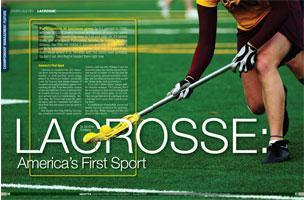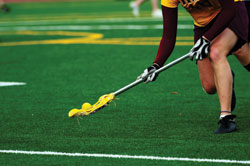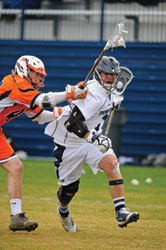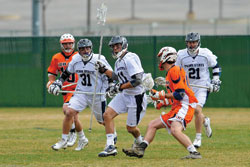
 Participation in lacrosse grew by 9.1 percent in 2008, with over 500,000 players involved as members of organized teams nationwide. That means if lacrosse isn't on your radar yet, it's headed there, and with speed. Fortunately, facilities for hosting lacrosse abound. You may not realize it, but you probably already have a perfectly suitable spot in your hometown right now. But even if you don't know where it is, the kids with the sticks have probably figured it out. And they're headed there right now.
Participation in lacrosse grew by 9.1 percent in 2008, with over 500,000 players involved as members of organized teams nationwide. That means if lacrosse isn't on your radar yet, it's headed there, and with speed. Fortunately, facilities for hosting lacrosse abound. You may not realize it, but you probably already have a perfectly suitable spot in your hometown right now. But even if you don't know where it is, the kids with the sticks have probably figured it out. And they're headed there right now.
America's first sport
Lacrosse is considered the first American sport. Arriving Europeans discovered a number of stick-and-ball sports being played by American Indians across the coast, but lacrosse was unique because of its netted stick and prohibition against ever touching the ball. Even that earlier version of lacrosse must have been as enticing then as modern lacrosse is today because the new arrivals took to it immediately. Before long, the French had given the sport its name, and the Canadians had taken it in as their own and raised it into the sport it is today.
But despite this long history, lacrosse has remained a relatively minor sport in America until recently. Perhaps it was the prominent place lacrosse has played in several movies or maybe it's the fact that the sport is getting national television coverage, but for whatever reason, more people are taking up the stick and loving it.
If you ask Colleen Sperry Aungst, public relations manager, US Lacrosse, that's the real reason for lacrosse's recent growth spurt. "It's the fastest game on two feet. Once you get that stick in your hand, throw a ball and score a goal, there's just no turning back."
A combination of basketball, soccer and hockey, lacrosse is touted as the sport anyone can play. While strength and size are prized in other sports, lacrosse rewards coordination, agility and speed.
Lacrosse Across America
Lacrosse is one of America's fastest growing sports, and that's a title the sport has held for the last decade. US Lacrosse, the sport's national governing body (NGB), has established chapters in 39 states as youth lacrosse participation has more than doubled in just seven years.
All that growth in such a short amount of time might create a dearth of facilities in some sports, but luckily, lacrosse can be played, as Aungst puts it, "wherever you've got a big enough square of grass." After that, you just need goals, boundaries drawn in the right places and an official. Now, that's not to say that there aren't specifications that can create an outstanding lacrosse facility, because America also offers some exceptional places to play lacrosse. But many communities are finding that they've got fantastic facilities already, and they usually find them where they are already playing football or soccer- and in at least one case, polo.
What to Look for in a Lacrosse Facility
One of the great things about lacrosse, and perhaps one of the reasons for its growing popularity, is that it's easy and relatively inexpensive to set up and play.
The first thing to consider is which sport you're planning - women's or men's lacrosse. While the two versions of the sport have a lot in common, they're also distinctly unique. According to US Lacrosse, the two versions differ in a number of ways, including rules, equipment, playing techniques and strategies. Another critical difference when you're planning a lacrosse event is the field size.
A regulation men's lacrosse field is roughly the same size as a football field, 110 yards from endline to endline. More consistent with the American Indian version of the game, women's lacrosse is played on a longer field with the endlines as much as 140 yards apart.
When US Lacrosse goes on a search for the perfect facility for one of their events, they take into consideration the number of fields that a facility can provide for simultaneous play as well as another key specification - lacrosse goals.
"We've used some amazing facilities," says Aungst. "We just got back from the Scottsdale Sports Complex, where we held the Women's Division Intercollegiate Associates National Championship. For that event we were looking for four fields in close proximity, so we could have a bunch of games going on at the same time. And of course, the facility provided goals so we didn't have to transport them."
The most critical considerations for lacrosse facilities are the right size field and enough fields to accommodate your event. After that, you only need to ensure that the facility can provide goals, and then it's game on.
Round Rock, Texas
Round Rock dubs itself the "Sports Capital of Texas" and they follow through on that promise in a major way. Their Old Settlers Park is a 570-acre sports complex with seven soccer fields, making it an ideal location for any tournament, but particularly a regional or national lacrosse tournament that would need several simultaneous fields of play.
 "We have hosted lacrosse events in the past, and we're really interested in hosting more," says Nancy Yawn, director, Round Rock Convention and Visitors Bureau. "There's been an influx of people moving to the Round Rock area, causing a huge growth in lacrosse. It's not your typical Texas sport but we definitely like it, and it's growing quickly in this area."
"We have hosted lacrosse events in the past, and we're really interested in hosting more," says Nancy Yawn, director, Round Rock Convention and Visitors Bureau. "There's been an influx of people moving to the Round Rock area, causing a huge growth in lacrosse. It's not your typical Texas sport but we definitely like it, and it's growing quickly in this area."
Round Rock's Sports Complex at Old Settlers Park received $18.9 million in improvements in 2008. The Park offers two lighted football fields and five regulation-size soccer fields, perfect for multiple fields of lacrosse play.
Long Island, New York
Lacrosse is huge in Long Island, with youth participation growing in the wake of several successful college teams, and they have the facilities to ensure that the sport has room to continue growing.
"We have a number of outdoor fields with about 12 fields altogether," says Jennifer Rothman, sports sales manager, Long Island Convention and Visitors Bureau. "Many of them are at our colleges and universities, and they're excellent facilities."
One of those facilities, James M. Shuart Stadium at Hofstra University,played host to the 2009 NCAA Division I Lacrosse Championship Northern Quarterfinals.
Long Island is also home to Mitchell Field, the official stadium of the Long Island Lizards, a professional men's lacrosse team. A centrally located 49-acre complex, Mitchell offers a new synthetic field ideal for football, soccer and lacrosse.
Long Island also offers options for taking lacrosse into the winter months at Southbay Sportsplex, a state-of-the-art indoor and outdoor sports facility. Southbay provides three 135 x 70-foot fields or one 210 x 135-foot full field, as well as a second floor viewing area and amenities like DirecTV and wireless Internet access.
State College, Pennsylvania
With Penn State at its heart, State College is definitely a sports town through and through. And like many other communities with a strong college lacrosse team, the sport is seeing enthusiastic growth and filling the area's facilities.
"It's definitely a growing sport here," says Shirley Smith, director of sales, Central Pennsylvania Convention and Visitors Bureau. "We have a good team, and we've also hosted the Big 10 and NCAA in lacrosse. So for us, lacrosse is really moving up the ladder to be on the level with football, baseball and basketball in terms of popularity."
Penn State's Jeffrey Field, home to the University's lacrosse team, received a 2003 face lift, giving the field a new surface, a press box and video booth, as well as bleachers that can accommodate up to 5,000 fans.
In addition to championships and tournaments, Penn State hosts an annual lacrosse summer camp, open to high school kids of any age who are interested in learning more about the sport.
Charleston, West Virginia
In Charleston, West Virginia, the lacrosse craze was actually started by two high school teams. George Washington High School had the first lacrosse team, but when Herbert Hoover High School wanted to get in on the game, that's when the spirit of lacrosse came out.
"There was actually a donation of equipment from one school to the other to help the new team get started," says Samantha Carney, sports sales manager, Charleston Convention and Visitors Bureau. "That's the kind of support there is here for lacrosse."
With coaches, parents and players banding together, they'll be bringing more tournaments to the area soon.
"The parents and coaches are talking with the West Virginia Secondary Schools Activities Commissions to plan a state tournament," says Carney. "They're also reaching out at the middle schools and starting practices and programs at the YMCA."
The University of Charleston Stadium will provide the ideal facility for these events and the many that are sure to follow. The stadium seats approximately 15,000, and a $1.4 million renovation gave the field a state-of-the-art makeover, including Momentum Turf 51 by Sportexe, purported to deliver the look, feel and safety of natural grass.
Palm County Sports Commission
Some communities make use of their soccer or football fields to make a place for lacrosse. Others get a bit more creative. Palm Beach County offers the ultimate location for a large lacrosse event at the International Polo Club in Wellington, Florida.
"They have seven polo fields at Wellington, which made the perfect location for the 2004 and 2005 US Field Hockey National Hockey Festival, and it would be just as perfect for lacrosse," says Charlie Dunn, marketing director, Palm Beach County Sports Commission. "You can fit five to six soccer size fields on a polo field, so we were able to provide a total of 28 fields at one location."
The Wellington fields feature Bermuda grass, which can be cut to any length depending on a sport's specifications, as well as a clubhouse and a stadium that accommodates about 1,500 seats on the main field.
While Wellington is an extraordinary facility, Palm Beach has even more to offer, including a wide variety of fields in Wellington's 114-acre Village Park, host to Spring Fling, one of the country's most prestigious women's lacrosse events.
Williamsport, Pennsylvania
Unless you're playing box lacrosse, which has its own set of rules and facility needs, lacrosse is typically an outdoor sport. But in some locations, winter hangs around too long for the satisfaction of local lacrosse lovers. And Williamsport, Pennsylvania has the ideal facility for those winter lacrosse tournaments or practice camps.
Constructed in 2006, the Generation Sports Complex Dome (GSC Dome) offers 135,000 square feet of field space equipped with AstroPlay field turf. The facility hosts everything from indoor football and soccer to rugby and, of course, lacrosse.
Depending on your event's needs, the dome can be divided into three separate fields or one large space and comes with amenities such as a conference room, concession stand and fitness area.
"Right now, our main lacrosse events include weekly practices for a club team from Lewisburg, and Lycoming College does a lot of preseason practices and scrimmages here," says Dan Johnson, program director, GSC Dome. "Lacrosse is definitely a growing sport here. In the future we'll offer adult leagues and kid's leagues too."
 Lacrosse Gains Momentum
Lacrosse Gains Momentum
With professional and college teams leading the way, lacrosse is blazing a trail into the hearts of America's young athletes. In 2008 alone, nearly1,000 new youth players picked up the game in Colorado. New Jersey's lacrosse players have grown by more than 22,000 athletes in the last seven years, and Washington State logged a 46 percent increase in youth players last year. And that's just a few examples.
Lacrosse facilities are not quite as numerous as its players, but still vast. It's possible to find the perfect facility for your event's needs, and America's convention and visitors bureaus and sports commissions are ready to help.
--------------------------------------------------------------------------------
US Lacrosse Participation Survey 2008. www.uslacrosse.org

